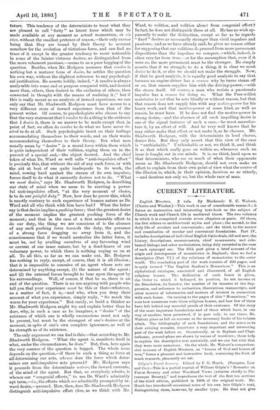CURRENT LITERATURE.
forms an instructive and interesting text-book on the subject of Church work and Church life in medimal times. The two volumes in which it is comprised contain seven chapters or parts. Of these, the first relates to architectural styles and plans ; the second, to the daily life of seculars and conventuals ; and the third, to the nature and constitution of secular and conventual foundations. Part IV,
includes descriptions of individual English Cathedrals, old and new, the history, descriptions, measurements, chief monuments, and cele- brated bishops and other ecclesiastics, being duly recorded in the case of each episcopal see. The fifth part gives a brief account of the origin and development of monasteries in England ; then we find a description (Part VI.) of the relations of monasteries to the outer world. The concluding part of the work consists of 230 pages, and is aptly termed "The English Student's Monasticon." This is an alphabetical catalogue, annotated and illustrated, of all English religious houses. The dedication of each house is given, the Order to which it belonged, its position, its net income at the Dissolution, its founder, the number of its inmates at the Sup- pression, and reference to authorities, illustrations, manuscripts, and other sources of information and matters of interest in connection with each house. On turning to the pages of this " Monasticon," we note how numerous were these religious houses, and how few of them have left behind any material proofs of their existence. Of the story of the more important foundations and of those which have, in one way or another, been preserved, if in part only, to our times, Mr. Walcott gives as full an account as the necessary limits of his volume admit. The bibliography of such foundations, and the notes as to their existing remains, constitute a very important and interesting part of the work before us. Occasionally, as in Bayham and Char- terhouse, ground-plans are shown by means of woodcuts; these help to explain the descriptive text materially, and we can but wish that they were more numerous. On the whole, Mr. Walcott's comprehen- sive account of English Minsters, as "houses of God and homes of men," forms a pleasant and instructive book, containing the fruit of much research, pleasantly set out.


































 Previous page
Previous page